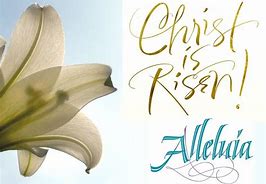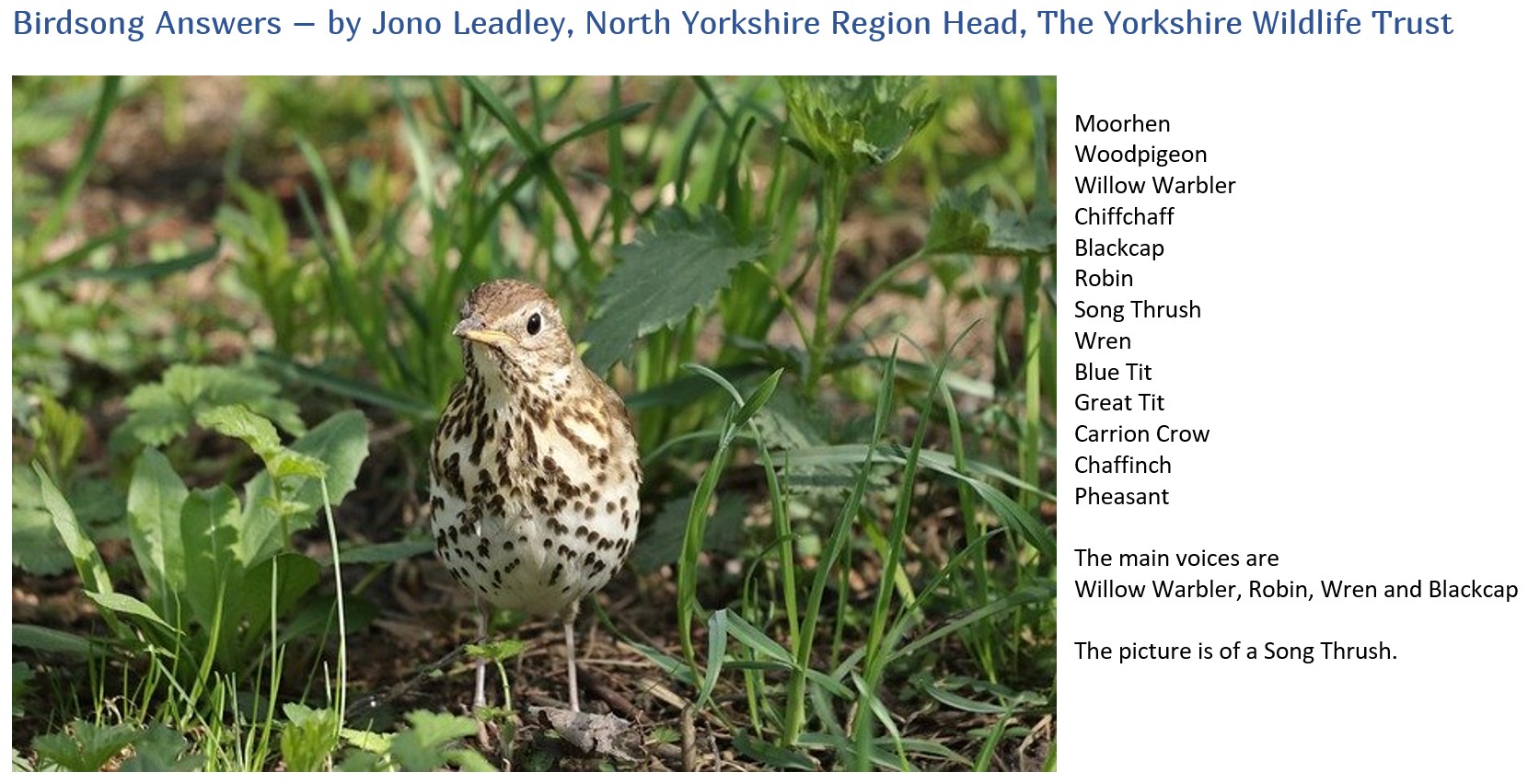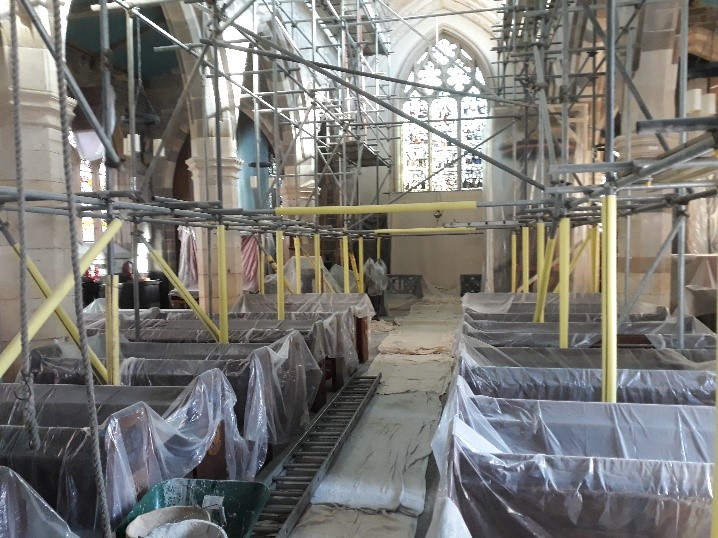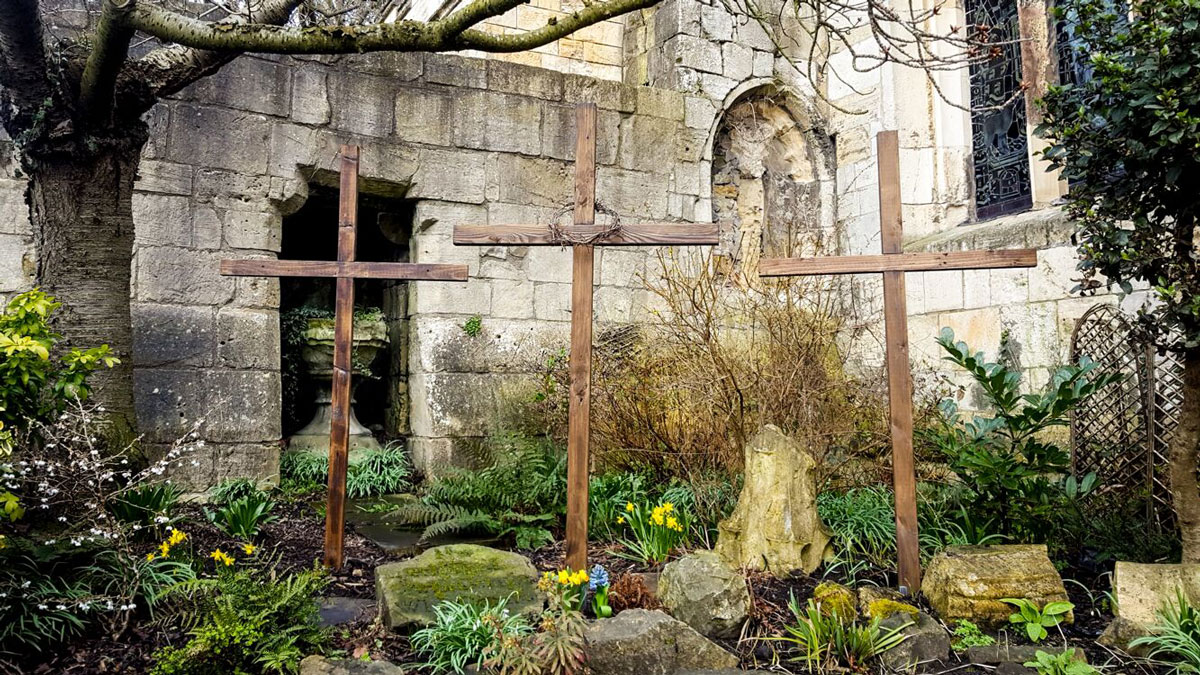Editor: The Revd Canon Derek Earis
Contents
- LETTER FROM AN EMPTY VICARAGE by Revd Kingsley Boulton, Deacon
- INTERNATIONAL DAWN CHORUS DAY by Ben Pugh
- JULIAN OF NORWICH by Revd Dr Gwynne Wright
- MAY 8 – 75th ANNIVERSARY OF VE DAY by Monica Lawrence and Revd Derek Earis
- RESTORATION WORK AT ALL SAINTS PAVEMENT by James Finlay
- JOTTINGS by Revd Derek Earis
- CITIZENS ADVICE YORK – STILL HERE TO HELP
LETTER FROM AN EMPTY VICARAGE by Revd Kingsley Boulton, Deacon

I am writing this not from an empty vicarage but from a house where I have been the sole occupant for five weeks and have not been allowed to welcome a single visitor. Social distancing and self-isolation are not exactly new ideas, though, and indeed form a not insignificant part of the Christian tradition. We think particularly of the great spiritual writer Julian of Norwich whom the Church of England commemorates this month on 8th May. She was confined to a single cell, whereas I at least have a whole house, however small, in which to move around.
Human beings are by nature social creatures. Relationships are important. We thrive when we are part of a community. As Christians we are part of a community of faith, the Church. Maintaining those connections is particularly vital in these strange and challenging times. This is where technology has come into its own. We can take part in online services. We can see and speak to each other in online meetings. We can keep in contact through the telephone, email and social media. This can all help us feel less isolated than we would otherwise be.
There is of course anxiety: fear that despite all the precautions we, or those dear to us, take we may become ill, either with the coronavirus itself or more generally. There is the uncertainty: not knowing how long the lockdown will last or how long we will have to remain isolated or confined. There is a wider concern about the effect on the country as a whole, on the economy, on people’s wellbeing, on their mental health, and particularly on the elderly and the vulnerable. These are all quite natural reactions to a situation that we have not encountered before.
It is easy to become despondent. Yet what has been so apparent is the resilience, ingenuity and compassion that the present crisis has brought out in so many people: the devotion and skill of those who work in hospitals, care homes and other services; the thoughtful acts of kindness shown to complete strangers who are isolated or vulnerable. It shows what goodness humanity is capable of. Looking to the future there will be other challenges once life begins to return to some form of normality. There will have to be changes, hopefully for the better.
People may ask: where is God in all this. The answer is: God is working through those human beings caring for others even at risk to themselves; God is working in those acts of kindness and love; God is working through the skill and devotion of those working for a vaccine and treatment. God is there. God is very much in the world. That is the Good News we are called to proclaim. For the Christian gospel is one of hope, of Easter hope. That hope is rooted in God’s love shown in the cross and in the resurrection of his Son Jesus Christ our Lord. Even in these difficult times “Alleluia” remains our song.
May you all keep well and be sustained with the hope and joy of this Easter season.
Kingsley.

INTERNATIONAL DAWN CHORUS DAY by Ben Pugh
Many have observed that in these quieter lockdown times bird song seems to be more prevalent!
Sunday 3rd of May was International Dawn Chorus Day. You can read a bit more about it here from The Wildlife Trusts.
Why not listen to the recording below taken at York’s Askham Bog, which features 12 (possibly 13) different species? Can you identify them?

JULIAN OF NORWICH by Revd Dr Gwynne Wright
Our time in isolation…
This month on 8 May 2020 we celebrate VE day and we remember the sacrifices that were made for that victory. 8 May is also the feast of Julian of Norwich and in different ways, Julian is once again, Julian is relevant ‘for such a time as this’. (Esther 4.14) Volumes have been written about Julian and her Revelations, although in fact, very little is known about her.

Julian of Norwich was born in about 1343 and lived through 3 waves of the Black Death, when about half the population of England died of the plague. Things were so dire that clergy often could not provide ‘last rites’. People were buried in mass graves. Julian would have known people who died, likely even members of her own family and mourned them, perhaps at a distance, unable to attend their funeral. She would have heard the bells of Norwich Cathedral tolling a mournful sound.
Julian near death
On the 8th of May 1373, Julian herself was near death at the age of thirty and a half. A priest was sent for and Julian was given the last rites. As she came near to death, Julian was presented with a vision of the crucifixion of our Lord. Christ’s pain and suffering as Julian witnessed it is told in her Revelations of Divine Love.
Social Distancing
Sometime afterwards she voluntarily adopted the life of an anchoress, living in solitary for the remainder of her life. Julian did not have emails, FaceBook, Zoom or any other means to connect with her wider world. Her vocation as an anchoress limited her social contact to her priest and servants. She would have had a single room with three windows: one for her maids, one for those who sought her guidance, and one for her to hear Mass. Her conversations with those who sought her spiritual counsel would have been through a window with a drape for privacy. Julian certainly practiced social distancing.

Living in isolation
Julian knew by choice what it was like to live isolated from others – many of us are isolating and don’t know how long this will last. Some think anchorites may have had access to a small enclosed garden, but we don’t read really know. Those of us with gardens can surely get some fresh air and see the burgeoning spring, but that is less easy for people living in apartments or high-rise flats. The solitary, limited, enclosed life is becoming more of a reality for many. Julian would have spent over twenty years living in isolation as an anchoress.
She could attend the Daily Offices and hear Mass through her window into the church, but not be physically in the church with others. We may not be able to physically go to church but appreciate opportunities to join with others online via prayer and worship websites. Some churches offer their own services via Facebook, YouTube or other wonders of modern technology. Julian may not have physically taken the consecrated elements at mass very often and it would have been ‘in one kind only’, the consecrated Host. Often she would have heard mass and watched through her window and made a ‘spiritual communion’, just as many of us are learning to do.
Dialogue with Jesus
During her Revelations, Julian engaged in a dialogue with Jesus, seeking to learn the truth of sin and suffering in our world. She challenged Jesus, as we might do questioning why such disease and suffering. Julian was no pollyanna, she felt alone, isolated and sometimes close to despair, as she wondered where was God in all this strife . She wrote:
“there are many deeds evilly done and such great harm given that it seems to us impossible that ever it should come to a good end; and we look upon this sorrowing and mourning so that we cannot take our ease in the joyful beholding of God as we would like to do.”
Jesus’ response are words we know as truth and should take to heart:
“I am able to make everything well…
Thou shalt see for thyself that all manner of thing shall be well.” (Ch 32)
We should hold to this promise of truth in our own time of crisis, disease and social isolation.
Jesus does not say that ‘You shall not be tempest-tossed, you shall not be work-weary, you shall not be dis-comforted,’ but he does say
“You shall not be overcome!”
We do not understand the how and why of our current covid-19 crisis. We too challenge God. Why, God?? Yet we see such goodness in our neighbours. We hear heartwarming stories of sharing such as Colonel Tom. So in the midst of all this illness, death, economic strife, we do find the goodness of God at work in our lives. He is with us always.
Jesus is the path of all love
So in our time of social distancing, especially in this Easter season. We know that Jesus is the path of all love, and Julian tells us why:
“Be well aware, love was His meaning
Who showed it thee? Love.
What showed He thee? Love.
Why did he show it thee? For Love.
Keep thyself in that love and thou shalt know and see more of the same –
In this love He has made all things beneficial to us,
and this love is everlasting.” (Ch 86)
We remember Julian on her feast day. As we now live in isolation, we come to new and deeper understanding of her life as an anchoress. In spite of the challenges of this pandemic and its aftermath, we can take comfort in our Lord’s promise to Julian:
All shall be well.
MAY 8 – 75th ANNIVERSARY OF VE DAY by Monica Lawrence and Revd Derek Earis

FROM THE YORK GROUP OF THE COMMUNITY OF THE CROSS OF NAILS
PEACE IN EUROPE
Healing the Wounds of History by Building a Culture of Peace
Living God, on this anniversary we give thanks for peace and freedom. We remember especially, all those on both sides of the conflict, who endured the horrors of war. In seeking your forgiveness, may we continue to heal the wounds of history by living reconciliation in our own lives, and responding to all that makes for peace. Amen. Blessed are the Peacemakers Matthew Ch 5 v 9
2020 marks the 75th anniversary of the end of WW2. The end of hostilities in Europe came on 8th May 1945, VE Day, and three months later on 15th August, Japan surrendered bringing World War 2 to an end on VJ Day. After six long years of war there was much to celebrate in the knowledge that armed conflict had ceased and the world was once more living in peace.
The Community of the Cross of Nails
In a spirit of reconciliation, the Community of the Cross of Nails, as many of you will know, came about soon after. To heal the wounds of history and to build a culture of peace was no doubt in the hearts and minds of many, who, with a purposeful vision, were keen to make that a reality. We endeavour to continue to do so today, having had the opportunity to learn the lessons of that past and to determine that those dark days of war will never be repeated at so much human cost.
The Community of the Cross of Nails however is not just about WW2. Whilst retaining its origins, it is a living, organic international community. It concerns itself with many other issues of peace, reconciliation and justice that are relevant in today’s world. Its third remit, of learning to live with difference and to celebrate diversity, is crucial nowadays in building a culture of peace. Community partners throughout the world endeavour to work in their various local contexts to enable peace and reconciliation. For more details of its reconciling work at home and abroad, please visit www.crossofnails.org. To join the York Group, please contact the Rev’d Kingsley Boulton, Deacon.
Marking the 75th anniversary of VE Day
Clearly the Pandemic has meant that many of the plans to celebrate VE Day on Friday 8th May have had to be postponed. It is likely they will take place as part of a joint celebration with VJ Day in August. However, it is good to remember the day as far as we can. One very practical way can be found on the website www.veday75.org which says:-
“We are also encouraging all those taking part to undertake the ‘Nation’s Toast to the Heroes of WW2’ at 3pm on the 8th May, from the safety of their own home by standing up and raise a glass of refreshment of their choice and undertake the following ‘Toast’ – “To those who gave so much, we thank you,” using this unique opportunity to pay tribute to the many millions at home and abroad that gave so much to ensure we all enjoy and share the freedom we have today.”
There are also other possible mainly celebratory activities suggested by English Heritage on https://english-heritage-news.org.uk/1CY6-6UHH6-D4SAV8V938/cr.aspx?v=0
Throughout those celebrations 75 years ago there are many references of people going into churches to pray giving thanks for the ending of war and hoping for a new era of peace. While we are preoccupied with our present health crisis we should not forget the need to work for peace in our day. This should be a vital part of celebrating those who gave their lives that we may have liberty from oppression and live our lives worthy of their sacrifice for us. Our Church of St Martin, part of the fellowship of the Coventry Cross of Nails, is dedicated to Peace and Reconciliation and each Friday at noon Revd Kingsley Boulton leads Friday prayers with this as its theme. On Friday 8th Kingsley will give an appropriate message with VE day in mind. It can be found at https://www.achurchnearyou.com/church/18967/news/
RESTORATION WORK AT ALL SAINTS PAVEMENT by James Finlay

Work started at All Saints Pavement in February to carry out some major restoration work following the most recent Quinquennial Inspection carried out in 2018. This included repairs to the stonework, replacement of worn out lead in the North Aisle roof, some repairs to the nave roof and the replacement of leadwork in the tower ad repairs to the windows at the clerestory level. The cost of the work will be around £125,000.

Despite the present situation work has continued without interruption and most of the work at the clerestory level is complete although some work has still to be completed on the windows. Until this has been completed the internal scaffolding will remain in place and everything inside the church remains covered in plastic sheeting and dust. It looks awful!
Work to replace the lead work at the top of the tower has been completed and very smart it looks too. We have however hit a problem with the replacement of the lead work at the lantern tower level in that when the old lead was removed the medieval oak beams underneath were found to have decayed at the ends which should have been holding them into position. The structural engineer, inspecting surveyor and contractor have devised a scheme to resolve this.
The work was due to be completed by the end of last month, but we now hope that everything will be finished by the end of May when we can undertake a deep clean.
JOTTINGS by Revd Derek Earis

Each morning I look out of our bathroom window onto Garden Street and it is always there. A big red van parked up. It is bright and shiny and just a couple of years old. There is no signwriting so I don’t know what it is used for. But on the passenger seat, neatly folded is a bright yellow safety jacket. To me it is a symbol of the lockdown. A symbol of a successful firm which has bought it to work and now must leave it idle. I think of that firm – whatever it does, and its owner and its workforce, forced now to be idle. I wonder when it will all end and when Britain can get back to work and how that business is managing despite the government grants and schemes. There are no easy answers, we all know that, but as well as praying for the sick and those who care for them I remember to add a prayer inspired by that van for its owner and his workforce.
I find I miss going into the church building more and more. It is another “old friend” I can’t visit. Presumably in there it is still Lent as no one is allowed to change the colours. It makes me think of the relationship between building and people. There was an email posting the other day which had two characters – one said “With COVID19 I have closed your churches” and the reply was “On the contrary! I have opened one in every home!” Yes, of course the church is people and all reading this and many other Christians have risen to the challenge. Worship continues, though from people’s homes. Yet the physical church building is also dear to us. In it is a repository of prayers and many many memories of significant occasions and encounters with God. We want to be back there again. When we are, let us not take it for granted, but cherish it as we would an old friend who has supported and guided us through the years.
In my walks I am discovering more and more areas of York previously unfamiliar to me. What used to be glimpses of streets from the car or the bike have now been walked down and observed. Here live real people and families. I find myself “rainbow spotting” – looking at the rainbow symbols and pictures and messages often from the children. They remind me not only of our wonderful NHS and its workers but also of those children inside, their parents their teachers and creativity undiminished. The hope of the generation to come. Or to be more precise a vital part of this generation. For as we are all “children of God” and all have much to learn and are bidden by Our Lord to enter into the kingdom of heaven “like a little child” so we have much to learn from the invisible hands and their drawings. Their commentary and witness teaches us to see things through their eyes and relinquish the obsession with things that ultimately do not matter and instead concentrate on the things that make a difference.
CITIZENS ADVICE YORK – STILL HERE TO HELP

